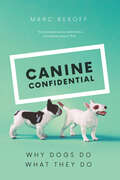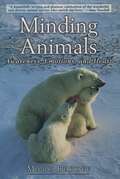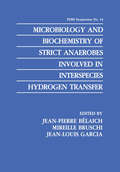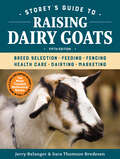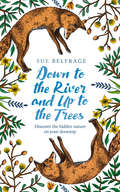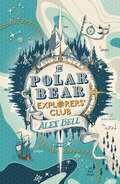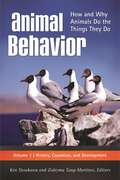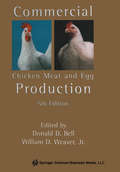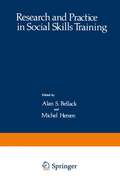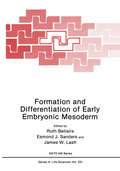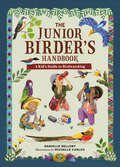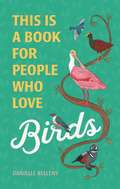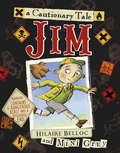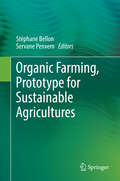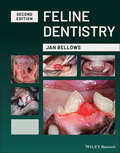- Table View
- List View
Canine Confidential: Why Dogs Do What They Do
by Marc BekoffFor all the love and attention we give dogs, much of what they do remains mysterious. Just think about different behaviors you see at a dog park: We have a good understanding of what it means when dogs wag their tails—but what about when they sniff and roll on a stinky spot? Why do they play tug-of-war with one dog, while showing their bellies to another? Why are some dogs shy, while others are bold? What goes on in dogs’ heads and hearts—and how much can we know and understand? Canine Confidential has the answers. Written by award-winning scientist—and lifelong dog lover—Marc Bekoff, it not only brilliantly opens up the world of dog behavior, but also helps us understand how we can make our dogs’ lives the best they can possibly be. Rooted in the most up-to-date science on cognition and emotion—fields that have exploded in recent years—Canine Confidential is a wonderfully accessible treasure trove of new information and myth-busting. Peeing, we learn, isn’t always marking; grass-eating isn’t always an attempt to trigger vomiting; it’s okay to hug a dog—on their terms; and so much more. There’s still much we don’t know, but at the core of the book is the certainty that dogs do have deep emotional lives, and that as their companions we must try to make those lives as rich and fulfilling as possible. It’s also clear that we must look at dogs as unique individuals and refrain from talking about “the dog.” Bekoff also considers the practical importance of knowing details about dog behavior. He advocates strongly for positive training—there’s no need to dominate or shame dogs or to make them live in fear—and the detailed information contained in Canine Confidential has a good deal of significance for dog trainers and teachers. He also suggests that trainers should watch and study dogs in various contexts outside of those in which they are dealing with clients, canine and human, with specific needs. There’s nothing in the world as heartwarming as being greeted by your dog at the end of the workday. Read Canine Confidential, and you’ll be on the road to making your shared lives as happy, healthy, and rewarding as they can possibly be.
Canine Confidential: Why Dogs Do What They Do
by Marc BekoffFor all the love and attention we give dogs, much of what they do remains mysterious. Just think about different behaviors you see at a dog park: We have a good understanding of what it means when dogs wag their tails—but what about when they sniff and roll on a stinky spot? Why do they play tug-of-war with one dog, while showing their bellies to another? Why are some dogs shy, while others are bold? What goes on in dogs’ heads and hearts—and how much can we know and understand? Canine Confidential has the answers. Written by award-winning scientist—and lifelong dog lover—Marc Bekoff, it not only brilliantly opens up the world of dog behavior, but also helps us understand how we can make our dogs’ lives the best they can possibly be. Rooted in the most up-to-date science on cognition and emotion—fields that have exploded in recent years—Canine Confidential is a wonderfully accessible treasure trove of new information and myth-busting. Peeing, we learn, isn’t always marking; grass-eating isn’t always an attempt to trigger vomiting; it’s okay to hug a dog—on their terms; and so much more. There’s still much we don’t know, but at the core of the book is the certainty that dogs do have deep emotional lives, and that as their companions we must try to make those lives as rich and fulfilling as possible. It’s also clear that we must look at dogs as unique individuals and refrain from talking about “the dog.” Bekoff also considers the practical importance of knowing details about dog behavior. He advocates strongly for positive training—there’s no need to dominate or shame dogs or to make them live in fear—and the detailed information contained in Canine Confidential has a good deal of significance for dog trainers and teachers. He also suggests that trainers should watch and study dogs in various contexts outside of those in which they are dealing with clients, canine and human, with specific needs. There’s nothing in the world as heartwarming as being greeted by your dog at the end of the workday. Read Canine Confidential, and you’ll be on the road to making your shared lives as happy, healthy, and rewarding as they can possibly be.
Minding Animals: Awareness, Emotions, and Heart
by Marc BekoffThinking bees, ice-skating buffaloes, dreaming rats, happy foxes, ecstatic elephants, despondent dolphins--in Minding Animals, Marc Bekoff takes us on an exhilarating tour of the emotional and mental world of animals, where we meet creatures who do amazing things and whose lives are filled with mysteries. Following in the footsteps of Konrad Lorenz and Niko Tinbergen, Bekoff has spent the last 30 years studying animals of every stripe--from coyotes in Wyoming to penguins in Antarctica. He draws on this vast experience, as well as on the observations of other naturalists, to offer readers fascinating stories of animal behavior, including grooming and gossip, self-medication, feeding patterns, dreaming, dominance, and mating behavior. Many of these stories are truly incredible--chimpanzees medicating themselves with herbal remedies, elephants clearly mourning a dead group member--but this is not simply a catalog of amazing animal tales, for Bekoff also sheds light on many of the more serious issues surrounding animals. He offers a thought-provoking look at animal cognition, intelligence, and consciousness and he presents vivid examples of animal passions, highlighting the deep emotional lives of our animal kin. All this serves as background for his thoughtful conclusions about humility and animal protection and animal well-being, where he urges a new paradigm of respect, grace, compassion, and love for all animals. Marc Bekoff has gone deep into the minds, hearts, spirits, and souls of animals, giving him profound insight into their lives, and no small insight into ours. Minding Animals is an important contribution to our understanding of animal consciousness, a major work that will be a must read for anyone who loves nature.
A Dog's World: Imagining the Lives of Dogs in a World without Humans
by Marc Bekoff Jessica PierceFrom two of the world’s leading authorities on dogs, an imaginative journey into a future of dogs without peopleWhat would happen to dogs if humans simply disappeared? Would dogs be able to survive on their own without us? A Dog’s World imagines a posthuman future for dogs, revealing how dogs would survive—and possibly even thrive—and explaining how this new and revolutionary perspective can guide how we interact with dogs now.Drawing on biology, ecology, and the latest findings on the lives and behavior of dogs and their wild relatives, Jessica Pierce and Marc Bekoff—two of today’s most innovative thinkers about dogs—explore who dogs might become without direct human intervention into breeding, arranged playdates at the dog park, regular feedings, and veterinary care. Pierce and Bekoff show how dogs are quick learners who are highly adaptable and opportunistic, and they offer compelling evidence that dogs already do survive on their own—and could do so in a world without us.Challenging the notion that dogs would be helpless without their human counterparts, A Dog’s World enables us to understand these independent and remarkably intelligent animals on their own terms.
Microbiology and Biochemistry of Strict Anaerobes Involved in Interspecies Hydrogen Transfer (F.E.M.S. Symposium Series #54)
by Jean-Pierre Bélaich Mireille Bruschi Jean-Louis GarciaThe belief that energy might be a limiting factor for the development of humanity led twenty years ago to a great interest being'taken in research on anaerobic digestion. The first international symposium held in Cardiff in 1979 was followed by the meetings in Travenmund (1981), Boston (1983), Guangzhou (1985) and Bologna (1988). By now anaerobic digestion has come to be recognized as an appropriate technology for waste treatment. More recently, the increase in the carbon dioxide content of the atmosphere and (in developed countries, especially_ in the EEC) the· fact that more and more land is becoming available for purposes other than food production make biomass production economically and/or socially feasible for industrial purposes. The possibility of using renewable organic carbon resources in this way is of great potential interest for developing biological techniques and could considerably increase the use of anaerobic micro-organisms in cellulose biotransformation and energy production from crop residues. This FEMS Symposium is devoted to the interspecies hydrogen transfer phenomenon involved in the mineralization of organic matter in anaerobiosis. This process is carried out in Nature by consortia of anaerobic micro-organisms living syntrophically. Many industrial applications of these consortia as black boxes for biogas production and waste treatment have been described. Although these early approaches were fruitful, it seems likely that a better knowledge at the molecular level of the more characteristic anaerobic bacteria which constitute these consortia would greatly increase and improve the utilization of these organisms.
Storey's Guide to Raising Dairy Goats, 5th Edition: Breed Selection, Feeding, Fencing, Health Care, Dairying, Marketing (Storey’s Guide to Raising)
by Jerry Belanger Sara Thomson BredesenWith 307,000 copies in print, this is the most trusted and comprehensive reference on every aspect of dairy goat care, housing, feeding, health care, breeding, and milking. The full-color new edition features the most up-to-date practices and a fresh new design.
Down to the River and Up to the Trees: Discover The Hidden Nature On Your Doorstep
by Sue Belfrage** A Winner of the Woodland Books of the Year Award ** In a stressful, chaotic world, many of us are turning to nature for a sense of serenity and happiness.
Studies on Large Branchiopod Biology and Aquaculture II (Developments in Hydrobiology #103)
by Denton Belk Henri J. Dumont G. MaierThis book contains a collection of papers dealing with various aspects of the biology and aquaculture of the large branchiopod crustacea; the Anostraca, Conchostraca, and Notostraca. Included are many of the papers presented at the Second International Large Branchiopod Symposium convened in Ulm, Germany, 30 July--3 August 1993. Additional manuscripts contributed by colleagues who were unable to attend are also included. A special feature of this volume is a checklist of the Anostraca, including information on distribution, location of type material, taxonomic problems, and literature references.
Studies on Large Branchiopod Biology and Aquaculture (Developments in Hydrobiology #64)
by Denton Belk Henri J. Dumont N. MunuswamyThe Polar Bear Explorers' Club (The Polar Bear Explorers' Club #1)
by Alex BellIt sounded like a respectable and worthy enough death for an explorer - tumbling from an ice bridge to be impaled upon a mammoth tusk - but Stella really, really didn't want that to happen, just the same.Join Stella Starflake Pearl and her three fellow explorers as they trek across the snowy Icelands and come face-to-face with frost fairies, snow queens, outlaw hideouts, unicorns, pygmy dinosaurs and carnivorous cabbages . . . When Stella and three other junior explorers get separated from their expedition can they cross the frozen wilderness and live to tell the tale?A gorgeously imaginative middle grade fantasy adventure combining the best of Peter Pan, Lemony Snicket, Northern Lights and Alice in Wonderland.'A magical adventure of friendship, bravery and derring-do in a richly imagined world.' The Bookseller'A fantastic frosty adventure.' Sunday Express'Wintry, atmospheric, highly imaginative fantasy.' Metro'The most huggable book of the year . . . An (iced) gem.' SFX
Animal Behavior [3 volumes]: How and Why Animals Do the Things They Do [3 volumes]
by Alison M. Bell Andrew P. King Anna Dornhaus Anne Danielson-François Anthony C. Little Benedict C. Jones Bennett G. Galef Brett M. Gibson Brian Keane Bronwyn H. Bleakley Çağlar Akçay Carolynn L. Smith Catherine A. Marler Charles T. Snowdon Christopher D. Watkins Christopher Harshaw Christopher S. Evans David B. Mcdonald David Clark David Crews David F. Sherry David J. White Douglas W. Mock Geoffrey E. Hill George Uetz Guillermo Paz-Y-Miño-c James L. Gould Janis L. Dickinson Jason Low Jeffrey R. Alberts Ken Yasukawa Kenyon B. Mobley Laura Smale Lee Alan Dugatkin Lee C. Drickamer Lisa M. Debruine Mark E. Hauber Matthew J. Fuxjager Megan Hastings Hagenauer Meredith J. West Michael D. Beecher Michael J. Ryan Michelle Pellissier Scott Nancy G. Solomon Rachel A. Page Renée A. Duckworth S. Craig Roberts Sarah Jane Alger Sean P. Bradley Terry J. Ord Theodore Stankowich Walter D. Koenig Ximena E. Bernal Zenobia Lewis Zuleyma Tang-MartínezDiscover why animals do what they do, based on their genes, physiologies, cultures, traditions, survival and mating advantages, and evolutionary histories—and find out how studying behavior in the animal world helps us understand human behavior.The three volumes of Animal Behavior: How and Why Animals Do the Things They Do cover the breadth of the field, addressing causation, development, function, and evolution in a wide range of animals, from invertebrates to humans. Inspired by Nobel laureate Nikolaas Tinbergen's work, the first two volumes follow Tinbergen's four classic questions of animal behavior, while the third volume supplies integrated examples of Tinbergen's investigative process applied in specific cases.Written in an engaging, accessible manner ideal for college students as well as general audiences, this evidence-based collection provides a fascinating tour of animal behaviorists' findings, such as how animal communication can be truthful or deceitful, the deadly serious business behind clashes in the "battle of the sexes," and how documentation of animal behavior can lead to a deeper understanding of human behavior. Each chapter provides both historical background and information about current developments in animal behavior knowledge.
The Christmas Guest: A heartwarming tale you won't want to put down
by Daisy BellThe heartwarming tale of a homeless puppy with a huge heart When Teddy runs away from home a week before Christmas, he is confronted by a cold, scary and oh, so big world. Then he finds the Woods family. With their kind hearts and cosy cottage, Teddy forms a special bond with Claire and Ben, but it's in little Emily that he finds the best friend he needs. But Emily is ill, and raising a puppy is hardly a priority for her stressed parents. If only he can prove to them how much happier he can make them all, Teddy might just find his forever home this Christmas...'A heart-melting Christmas story about the sweetest little dog bringing happiness to a family' Amazon reviewer.
Commercial Chicken Meat and Egg Production
by Donald D. BellCommercial Chicken Meat and Egg Production is the 5th edition of a highly successful book first authored by Dr. Mack O. North in 1972, updated in 1978 and 1984. The 4th edition was co-authored with Donald D. Bell in 1990. The book has achieved international success as a reference for students and commercial poultry and egg producers in every major poultry producing country in the world. The 5th edition is essential reading for students preparing to enter the poultry industry, for owners and managers of existing poultry companies and for scientists who need a major source of scientifically based material on poultry management. In earlier editions, the authors emphasized the chicken and its management. The 5th edition, with the emphasis shifted to the commercial business of managing poultry, contains over 75% new material. The contributions of 14 new authors make this new edition the most comprehensive such book available. Since extensive references are made to the international aspects of poultry management, all data are presented in both the Imperial and Metric form. Over 300 tables and 250 photos and figures support 62 chapters of text. New areas include processing of poultry and eggs with thorough discussions of food safety and further processing. The business of maintaining poultry is discussed in chapters on economics, model production firms, the use of computers, and record keeping. Updated topics include: breeders and hatchery operations; broiler and layer flock management; replacement programs and management of replacements; nutrition; and flock health. New chapters address flock behavior, ventilation, waste management, egg quality and egg breakage. Other new features include a list of more than 400 references and a Master List of the tables, figures, manufacturers of equipment and supplies, research institutions, books and periodicals, breeders, and trade associations. Commercial growers will find the tables of data of particular interest; scientists will be able to utilize the extensive references and to relate their areas of interest to the commercial industry's applications; and students will find that the division of the book into 11 distinct sections, with multiple chapters in each, will make the text especially useful.
Evidence Based Equine Nutrition: A Practical Approach For Professionals
by Nikki Bell Louise Jones Rod Fisher Faith Burden Bryony WitherowThis book uniquely provides both the scientific basis of equine nutrition and the translation of that science into practical, day-to-day feeding advice. It summarises the latest research to provide readers with the evidence base needed to both confidently advise those who want to understand the science behind equine nutrition, and apply that evidence into practical advice for anyone who just wants to know how to feed horses. Both veterinary and animal science courses struggle to provide adequate nutrition training within their syllabuses. Much of the general information available is poorly explained and not evidence based. This book fills that gap, with the author team relaying over 50 cumulative years' experience teaching equine nutrition to both practising clinicians and students. Find answers to the most common queries and challenges encountered during nutritional consultations across 17 informative chapters, using typical case-based examples as experienced by the authors. Fully supported throughout with visual aids and photographic illustrations, they show how to easily increase compliance and understanding. Key topics covered include: How to take a diet history, including which forage and concentrates are most appropriate, and how to interpret the information on feed labels; How to take the horse's history, including workload, body weight and body fat scoring; Supporting achievable and sustainable fat loss in overweight horses; Appropriate rations across a range of performance disciplines and for breeding horses; Appropriate feeds and supplements for competition, including how to recognise potential hazards, signs of quality and issues of feed safety; How to use ration programmes, including a range of frequently asked questions for horses with specific nutritional requirements from allergies to obesity. A recommended resource to support the teaching of veterinary nutrition, this book should also be found on the bookshelf of all veterinarians, animal scientists, trainers, nutritionists, and nutritional advisors. This book includes forewords by Carl Lester, Honorary Fellow of the British Horse Society and recipient of an MBE for his services to Equestrianism, and Tim Mair, former President of the British Equine Veterinary Association.
Cockroaches: Ecology, Behavior, and Natural History
by William J. Bell Louis M. Roth Christine A. NalepaThe cockroach is truly an evolutionary wonder. This definitive volume provides a complete overview of suborder Blattaria, highlighting the diversity of these amazing insects in their natural environments. Beginning with a foreword by Edward O. Wilson, the book explores the fascinating natural history and behavior of cockroaches, describing their various colors, sizes, and shapes, as well as how they move on land, in water, and through the air. In addition to habitat use, diet, reproduction, and behavior, Cockroaches covers aspects of cockroach biology, such as the relationship between cockroaches and microbes, termites as social cockroaches, and the ecological impact of the suborder. With over 100 illustrations, an expanded glossary, and an invaluable set of references, this work is destined to become the classic book on the Blattaria. Students and research entomologists can mine each chapter for new ideas, new perspectives, and new directions for future study.
Searching Behaviour: The behavioural ecology of finding resources (Chapman & Hall Animal Behaviour Series)
by W.J. BellThis is a book about proximate mechanisms. Although some theoreti cal structure is used to introduce the subject, the intent is to offer a comprehensive view of the mechanistic side of searching (or foraging) so as to balance the current emphasis of books on mathematical and functional models. It seems to me that the pendulum needs to swing back to studies of how animals behave, and that maybe in so doing models will become valuable again in driving experimentation. I have probably included too many examples in this book, and some are even presented in great detail. Hopefully, they provide a complete picture of the kind of animals used, the experimental setup, the kinds of data yielded, and how the data were analysed. I have done this in response to frustrating experiences of reading chapters in behavioural ecobgy books that provide insufficient information with which to evaluate an author's conclusion.
Research and Practice in Social Skills Training
by A.S. Bellack M. HersenIt is perhaps trite to refer to human beings as social animals, but never theless it is true. A substantial portion of our lives is spent in interactions with other people. Moreover, the nature, quality, and quantity of those interactions have a tremendous impact on behavior, mood, and the adequacy of adjustment. Faulty interpersonal relationship patterns have reliably been associated with a wide variety of behavioral-psychological dysfunctions ranging from simple loneliness to schizophrenia. Most "traditional" analyses of interpersonal failures have viewed them as consequences or by-products of other difficulties, such as anx iety, depression, intrapsychic conflict, or thought disorder. Con sequently, remediational efforts have rarely been directed to interper sonal behavior per se. Rather, it has been expected that interpersonal relationships would improve when the source disorder was eliminated. While this model does account for some interpersonal dysfunctions (e.g., social anxiety can inhibit interpersonal behavior), it is not adequate to account for the vast majority of interpersonal difficulties. In fact, in many cases those difficulties either are independent of or underlie other dysfunctions (e.g., repeated social failure may produce depression or social anxiety).
Formation and Differentiation of Early Embryonic Mesoderm (Nato Science Series A: #231)
by Ruth Bellairs Esmond J. Sanders James W. LashMesodenn is a key tissue in early development. It is involved in the differentiation of almost every organ in the body, not merely as a structural component, but as an active participant in the establishment of diverse cell types. All mesodenn is derived from ectoderm. Its appearance signals the start of a significant new phase in the development of the embryo. At this time all three genn layers are now present and myriad sequences of cell and tissue interactions begin to occur which will eventually give rise to the entire embryo. The control of the growth and differentiation of the mesoderm is critical for the production of a normal individual. Indeed, disturbance of the patterning of the mesoderm or of its interaction with other tissues plays a critical part in the fonnation of most congenital anomalies. The main focus of this book is therefore on the establishment, divergence and specialisation of mesodermal derivatives. The central role of the mesoderm in development has long been appreciated and a wide literature exists on its activity in certain specialised situations. Recently, however, an impetus to its study has been provided by new approaches opened up through biotechnological advances. Many of these advances are reflected in the reports in this volume. Scientists from various disciplines have become drawn to mesodermal tissues, and this volume may help them find a framework within which their work will fit.
The Junior Birder's Handbook: A Kid's Guide to Birdwatching (The Junior Handbook Series)
by Danielle BellenyA beautifully illustrated kid's guide to birds and their habitats, perfect for budding birders whether you live in a city, suburb, or rural area. In the woods, in cities, in your backyard—birds are everywhere. But do you know the difference between a robin and a wren? A raven and a crow? In this fully illustrated book, you will learn how to identify birds in an array of habitats and seasons (thanks to migration, there are always new birds to find). You'll also learn the different behaviors/habits of birds—from why blue jays divebomb other birds&’ nests to what attracts hummingbirds to certain flowers. As the popularity of birding and birdwatching reach new heights, more and more children have the opportunity to connect with nature, whether indoors or outside and with no equipment other than one&’s eyes (and this handbook, of course). What&’s not to love? Featuring Michelle Carlos's vibrant illustrations, this gorgeous (and gifty) book includes interactive elements like quizzes and crafts, as well as accessible charts/guides that will lead to endless fun!
This Is a Book for People Who Love Birds (This Is a Book for People Who Love)
by Danielle BellenyFull of bird watching basics, fun facts, and illustrated species profiles, This Is a Book for People Who Love Birds is a joyful celebration of our feathered friends!For seasoned spotters and backyard hobbyists alike, this charming guide offers an accessible look at the irresistible world of birding. Wildlife biologist and co-founder of Black Birders Week Danielle Belleny walks readers through the essentials of bird watching, from equipment to locations, offering new ideas for finding avian friends wherever you may be. Engaging profiles of North American bird species, from cardinals and blue jays to raptors and sea birds, are accompanied by whimsical illustrations sure to spark the imaginations of birders from coast to coast. Deeply researched and accessible to enthusiasts of all levels of experience, This Is a Book for People Who Love Birds is an essential addition to every bird lover's field library.
Freshwater Algae: Identification, Enumeration and Use as Bioindicators
by Edward G. Bellinger David C. SigeeThis is the second edition of Freshwater Algae; the popular guide to temperate freshwater algae. This book uniquely combines practical information on sampling and experimental techniques with an explanation of basic algal taxonomy plus a key to identify the more frequently-occurring organisms. Fully revised, it describes major bioindicator species in relation to key environmental parameters and their implications for aquatic management. This second edition includes: the same clear writing style as the first edition to provide an easily accessible source of information on algae within standing and flowing waters, and the problems they may cause the identification of 250 algae using a key based on readily observable morphological features that can be readily observed under a conventional light microscope up-to-date information on the molecular determination of taxonomic status, analytical microtechniques and the potential role of computer analysis in algal biology upgrades to numerous line drawings to include more detail and extra species information, full colour photographs of live algae – including many new images from the USA and China Bridging the gap between simple identification texts and highly specialised research volumes, this book is used both as a comprehensive introduction to the subject and as a laboratory manual. The new edition will be invaluable to aquatic biologists for algal identification, and for all practitioners and researchers working within aquatic microbiology in industry and academia.
Freshwater Algae: Identification, Enumeration and Use as Bioindicators
by Edward G. Bellinger David C. SigeeThis is the second edition of Freshwater Algae; the popular guide to temperate freshwater algae. This book uniquely combines practical information on sampling and experimental techniques with an explanation of basic algal taxonomy plus a key to identify the more frequently-occurring organisms. Fully revised, it describes major bioindicator species in relation to key environmental parameters and their implications for aquatic management. This second edition includes: the same clear writing style as the first edition to provide an easily accessible source of information on algae within standing and flowing waters, and the problems they may cause the identification of 250 algae using a key based on readily observable morphological features that can be readily observed under a conventional light microscope up-to-date information on the molecular determination of taxonomic status, analytical microtechniques and the potential role of computer analysis in algal biology upgrades to numerous line drawings to include more detail and extra species information, full colour photographs of live algae – including many new images from the USA and China Bridging the gap between simple identification texts and highly specialised research volumes, this book is used both as a comprehensive introduction to the subject and as a laboratory manual. The new edition will be invaluable to aquatic biologists for algal identification, and for all practitioners and researchers working within aquatic microbiology in industry and academia.
Jim (Joy Street Bks.)
by Hilaire BellocAward-winning illustrator Mini Grey turns her inimitable hand to Hilaire Belloc's classic cautionary tale of Jim: who ran away from his Nurse and was eaten by a Lion!First published in 1907, Belloc's wickedly funny poem describing the sad end of Jim is fabulously illustrated in a magical picture book edition. This is darkly comic, word of warning about the dangers of being spoiled is the perfect tongue-in-cheek corrective for little ones who have been a little overindulged!
Organic Farming, Prototype for Sustainable Agricultures: Prototype For Sustainable Agricultures
by Stéphane Bellon Servane PenvernStakeholders show a growing interest for organic food and farming (OF&F), which becomes a societal component. Rather than questioning whether OF&F outperforms conventional agriculture or not, the main question addressed in this book is how, and in what conditions, OF&F may be considered as a prototype towards sustainable agricultures. The book gathers 25 papers introduced in a first chapter. The first section investigates OF&F production processes and its capacity to benefit from the systems functioning to achieve higher self-sufficiency. The second one proposes an overview of organic performances providing commodities and public goods. The third one focuses on organics development pathways within agri-food systems and territories. As well as a strong theoretical component, this book provides an overview of the new challenges for research and development. It questions the benefits as well as knowledge gaps with a particular emphasis on bottlenecks and lock-in effects at various levels.
Feline Dentistry
by Jan BellowsThe most up-to-date version of the leading resource on veterinary dentistry in cats The Second Edition of Feline Dentistry delivers a comprehensive exploration of the specific considerations required to provide dental care to cats that emphasizes their unique needs. The updated Second Edition includes brand-new material and approximately 300 new images illustrating diseases, conditions, and procedures discussed within the book. The new edition combines the pathology and treatment information to provide additional context which helps make it more clinically relevant. The book also offers: A thorough introduction to feline oral assessment, including anatomy, oral examinations, radiology, and charting Comprehensive explorations of dental pathology and treatment in cats, including necessary equipment and materials and anesthesia and pain control Practical discussions of dental pathology prevention in felines, including plaque and tartar control Perfect for veterinary general practitioners and veterinary students, Feline Dentistry Second Edition will also be useful to veterinary technicians seeking a one-stop, visual resource on feline-specific dentistry.
